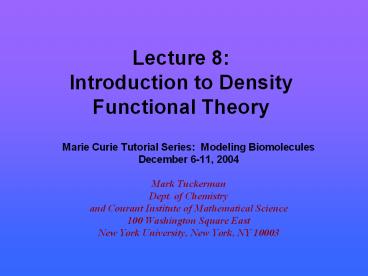Lecture 8: Introduction to Density Functional Theory - PowerPoint PPT Presentation
1 / 29
Title:
Lecture 8: Introduction to Density Functional Theory
Description:
Introduction to Density Functional Theory. Marie Curie Tutorial Series: Modeling Biomolecules ... and Courant Institute of Mathematical Science. 100 Washington ... – PowerPoint PPT presentation
Number of Views:1178
Avg rating:3.0/5.0
Title: Lecture 8: Introduction to Density Functional Theory
1
Lecture 8Introduction to Density Functional
Theory
- Marie Curie Tutorial Series Modeling
Biomolecules - December 6-11, 2004
- Mark Tuckerman
- Dept. of Chemistry
- and Courant Institute of Mathematical Science
- 100 Washington Square East
- New York University, New York, NY 10003
2
Background
- 1920s Introduction of the Thomas-Fermi model.
- 1964 Hohenberg-Kohn paper proving existence
of exact DF. - 1965 Kohn-Sham scheme introduced.
- 1970s and early 80s LDA. DFT becomes useful.
- 1985 Incorporation of DFT into molecular
dynamics (Car-Parrinello) - (Now one of PRLs top 10 cited
papers). - 1988 Becke and LYP functionals. DFT useful for
some chemistry. - 1998 Nobel prize awarded to Walter Kohn in
chemistry for - development of DFT.
3
(No Transcript)
4
External Potential
5
Total Molecular Hamiltonian
Born-Oppenheimer Approximation
v
6
Hohenberg-Kohn Theorem
- Two systems with the same number Ne of electrons
have the same - Te Vee. Hence, they are distinguished only
by Ven. - Knowledge of ?0gt determines Ven.
- Let V be the set of external potentials such
solution of - yields a nondegenerate ground state ?0gt.
- Collect all such ground state wavefunctions
into a set ?. Each - element of this set is associated with a
Hamiltonian determined by the external - potential.
- There exists a 11 mapping C such that
- C V ?
7
(No Transcript)
8
(No Transcript)
9
Hohenberg-Kohn Theorem (part II)
Given an antisymmetric ground state wavefunction
from the set ?, the ground-state density is
given by
Knowledge of n(r) is sufficient to determine ?gt
Let N be the set of ground state densities
obtained from Ne-electron ground state
wavefunctions in ?. Then, there exists a 11
mapping
D-1 N ?
D ? N
The formula for n(r) shows that D exists,
however, showing that D-1 exists Is less trivial.
10
Proof that D-1 exists
11
(No Transcript)
12
(No Transcript)
13
(CD)-1 N V
The theorems are generalizable to degenerate
ground states!
14
The energy functional
The energy expectation value is of particular
importance
From the variational principle, for ?gt in ?
Thus,
Therefore, En0 can be determined by a
minimization procedure
15
(No Transcript)
16
(No Transcript)
17
(No Transcript)
18
(No Transcript)
19
(No Transcript)
20
(No Transcript)
21
(No Transcript)
22
The Kohn-Sham Formulation
Central assertion of KS formulation Consider a
system of Ne Non-interacting electrons subject
to an external potential VKS. It Is possible
to choose this potential such that the ground
state density Of the non-interacting system is
the same as that of an interacting System
subject to a particular external potential Vext.
A non-interacting system is separable and,
therefore, described by a set of single-particle
orbitals ?i(r,s), i1,,Ne, such that the wave
function is given by a Slater determinant
The density is given by
The kinetic energy is given by
23
(No Transcript)
24
(No Transcript)
25
(No Transcript)
26
Some simple results from DFT
Ebarrier(DFT) 3.6 kcal/mol Ebarrier(MP4) 4.1
kcal/mol
27
Geometry of the protonated methanol dimer
2.39Å
MP2 6-311G (2d,2p) 2.38 Å
28
Results methanol
Dimer dissociation curve of a neutral dimer
Expt. -3.2 kcal/mol
29
Lecture Summary
- Density functional theory is an exact
reformulation of many-body - quantum mechanics in terms of the
probability density rather than - the wave function
- The ground-state energy can be obtained by
minimization of the - energy functional En. All we know about
the functional is that - it exists, however, its form is unknown.
- Kohn-Sham reformulation in terms of
single-particle orbitals helps - in the development of approximations and is
the form used in - current density functional calculations
today.































